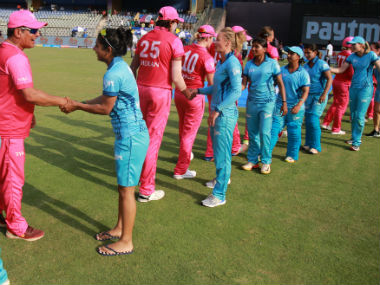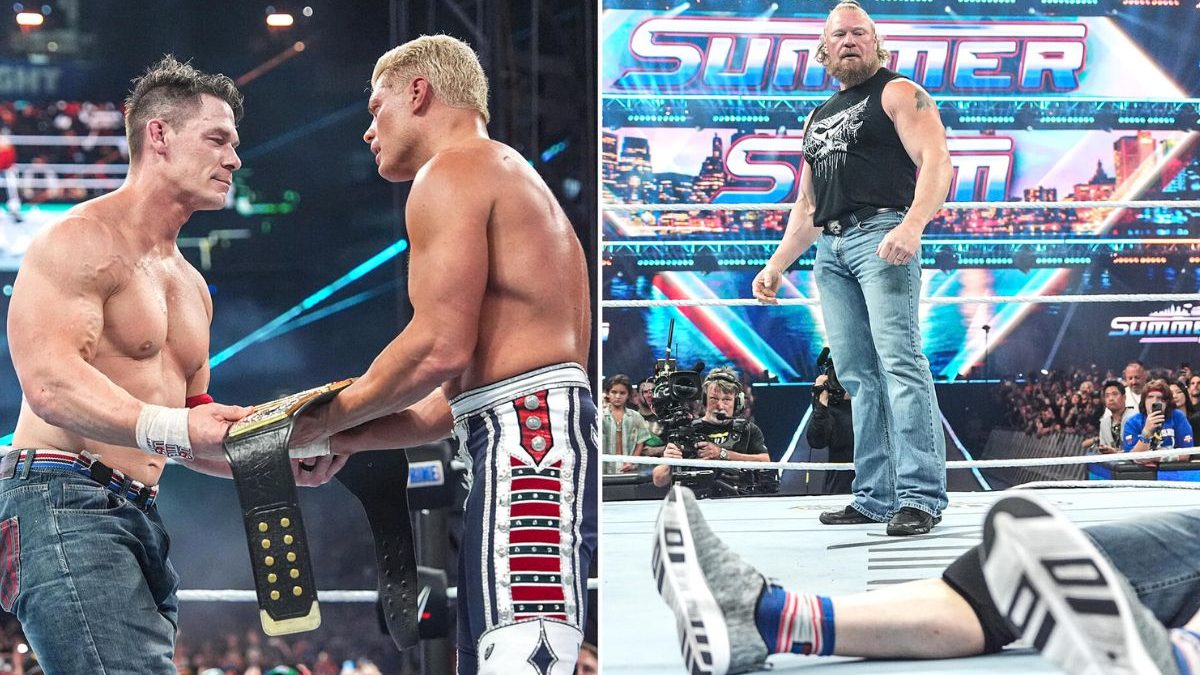“We are very excited and were waiting since a long time for when we could play in an IPL-like tournament. We are happy that we have got an opportunity,” Harmanpreet Kaur told reporters ahead of the historic Women’s T20 Challenge organised by the Board of Control for Cricket in India last year. Only, in this case, opportunity meant playing a one-off, exhibition game in the sweltering haze of Mumbai in May at 2 pm. [caption id=“attachment_4479335” align=“alignleft” width=“380”] Players shake hands at the end of the match, with the Supernovas winning by three wickets. Sportzpics[/caption]
The match — hosted at the iconic Wankhede before the Qualifier 1 between Sunrisers Hyderabad and Chennai Super Kings — was a good way for the BCCI to gauge audience reaction to the idea of a women’s T20 league in India on the lines of the IPL. Unfortunately, since the board decided to schedule the game at 2 in the afternoon, it meant that any fans wanting to watch the game would have to spend a good 9 or 10 hours in the sweltering May heat at the stadium. Predictably, not many fans turned up. But the BCCI will have an
expanded version again this season, running between seven to 10 days and played by three teams this time around. “BCCI would decide the teams as there aren’t any proper bidders who are interested in buying women’s teams. Yes, we might rope in a few good sponsors. So at the moment, the BCCI will have to pay the players, including the match fees of foreign players, along with a decent prize money,” The Press Trust of India
quoted an unnamed BCCI official as saying. The BCCI official went on to lament ‘logistical issues’ in hosting the women’s event. Considering the BCCI shifted the entire league to South Africa due to the General Elections in 2009 —and were considering moving the league out again in the upcoming edition should the need arise — the cash-rich governing body’s concerns about logistics and money are…well, rich. But the fact that it took 11 editions of the IPL before the women’s league got a platform — or something that at least resembles one — is particularly revealing. But hardly surprising. After all, don’t most sports in India have glitzy leagues for men, while the women’s competitions exist on the periphery? Of course there’s the Pro Wrestling League, the Premier Badminton League and Ultimate Table Tennis where men and women occupy the same position on the pedestal. “Of course, the Pro Wrestling League is a unique concept. It doesn’t matter in that league whether you are a male player or a female player. All of us are treated equally,” said Sakshi Malik, a Rio Olympics bronze medal-winning wrestler who is sponsored by JSW. “But of late there has been a sea change in the way women’s sport is perceived in India. Back when I had started, there weren’t too many women taking up sports as a career. And I chose a career which was perceived as solely a men’s preserve. But now there are so many female wrestlers who compete under the Indian flag.” Malik’s medal in Brazil, coupled with PV Sindhu’s silver in women’s singles badminton, was a turn-of-the-page event of sort for women’s sports in India. It was at Rio 2016 that two women had returned from an Olympics with medals while all their male compatriots had come back empty-handed. Two years down the line, women athletes — be it Vinesh Phogat and Sakshi in wrestling, Apurvi Chandela and Manu Bhaker in shooting or Mary Kom in boxing — have become the biggest flagbearers in many Olympic sports. Experiments with women’s events But when it comes to other team-based sports, the Hockey India League and the Indian Super League have no rivals of the same stature in the women’s event. And just like the IPL, other leagues like Pro Kabaddi League and Pro Volleyball have made forays into women’s sport. While PKL held the Women’s Kabaddi Challenge for one season in 2016, the league last season held the KBD Juniors event instead of the Women’s Kabaddi Challenge, essentially abandoning the women’s kabaddi initiative. On the other hand, Pro Volleyball, which saw its first season ending just last month, had one exhibition game played on the sidelines of the men’s tournament. “But at least that game was played on the same day as the final, so we gave them that spotlight,” said Tuhin Mishra, the MD and Co-Founder of Baseline Venture, whose brainchild the volleyball league is. “Besides, we didn’t need to wait for 10 seasons to try something for the women, we tried something in the first edition itself. We’re certain of launching the women’s league in a year or two.” Mishra also said that the contracts they have signed with all six existing franchise owners gives them the first right of refusal should the Pro Volleyball League decide to launch a women’s league as well in the near future. “The big problem we faced while discussing the women’s volleyball league was that there were not too many female players who could have been distributed across the six teams. The pool of good players we had in India when we were in the planning phase was around 30-40, while we would have needed at least 60 players for a women’s league. But we strongly feel that a women’s league in volleyball will do well in India.” While the Hockey India League was organised by Hockey India for five seasons, they chose to postpone the 2018 edition. There are rumours that the league will return this year, but with a twist: instead of 11-a-side men’s teams, there will be five-a-side men’s, women’s and mixed teams under each franchise. On being asked by Firstpost, Elena Norman, the CEO of HI, refused to confirm the development saying, “No plan has been finalised yet in terms of format of the Hockey India Leagues next edition. We will share details in due time.” However, on being asked whether a women’s league was always in the scheme of things for HI, she said: “Having women’s tournaments is always a consideration. The scale of events often also depends on sponsors coming on board. We are also keen to bring global events to India. We have bid to host the next Men’s and Women’s Hockey World Cups. This will help to amplify the profile of the sport and build local fans for women’s hockey.” She added: “The five-a-side format brings to life our belief and core form of functioning as a federation. We feel five-a-side gives an equal opportunity across players and has proven to be a successful experiment. It has already gained a lot of acceptance from spectators. We have had five-a-side tournaments in Maharashtra and Karnataka with big spectator turn outs. The response is great and we look forward to using such innovative formats to reach out to a wider audience for the sport.” Hopefully, by the time the next International Women’s Day rolls around, athletes like Harmanpreet will not have to find contentment in playing just a handful of games on the sidelines of the men’s event.
Since 2016 Rio Olympics, women athletes are among the biggest flagbearers in their respective sports. Yet, when it comes to sporting leagues, women’s leagues often exist on the periphery.
Advertisement
End of Article
Written by Amit Kamath
Amit Kamath is with the sports desk in Mumbai. He covers Olympic sports like wrestling, shooting, and boxing besides also writing about NBA and kabaddi. In 2014, he was declared the runner-up in the sports category at the National RedInk Award for Excellence in Journalism for his story on Sports Authority of India's Kandivli campus where world-class athletes had to put up with appalling conditions. He was a Robert Bosch Media Ambassador in 2019. see more


)

)
)
)
)
)
)
)
)



